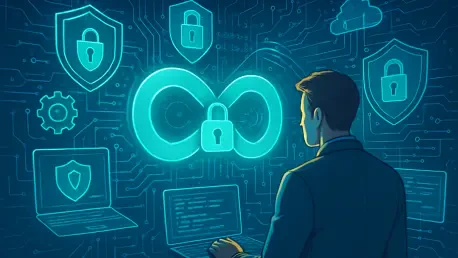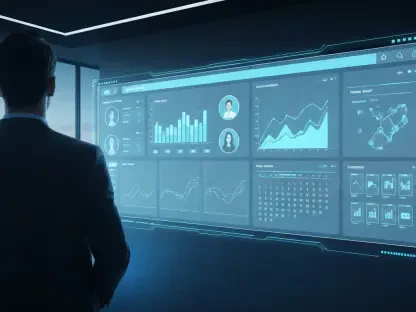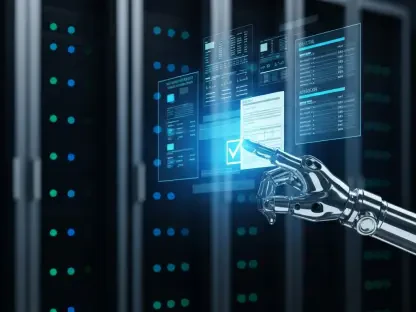In an era where digital transformation is reshaping every facet of business and society, the specter of cyber threats looms larger than ever, with data breaches and ransomware attacks becoming alarmingly common and costing organizations millions annually. Enter DevSecOps, a groundbreaking methodology that integrates security into the core of software development and operations, promising a future where vulnerabilities are addressed before they become catastrophic. By 2032, this approach is expected to fundamentally redefine cybersecurity, shifting the paradigm from reactive fixes to proactive defense. The DevSecOps market, valued at USD 8.93 billion in 2024, is projected to skyrocket to USD 26.21 billion by 2032, reflecting a compound annual growth rate of 14.6%. This staggering growth underscores a critical realization: security can no longer be an afterthought but must be woven into every stage of the development lifecycle. As cyber threats grow in sophistication, the urgency for organizations to adopt DevSecOps intensifies, positioning it as a cornerstone of modern digital resilience. But what forces are driving this seismic shift? How will emerging technologies and global trends influence its trajectory? This exploration delves into the key drivers, challenges, and opportunities that will shape the role of DevSecOps in safeguarding the digital landscape over the next several years, offering a glimpse into a safer, more secure tomorrow.
The Rising Tide of Cyber Threats and Regulatory Demands
The relentless surge of cyber threats stands as a primary catalyst for the widespread adoption of DevSecOps, with data breaches alone costing an average of USD 4.5 million in 2023, a figure that has risen sharply in recent years. Ransomware, supply chain attacks, and other malicious activities have evolved into routine challenges for organizations across industries, inflicting not only financial losses but also severe reputational damage. DevSecOps addresses this crisis by embedding security protocols from the earliest stages of software development, ensuring that vulnerabilities are identified and mitigated before they can be exploited. This proactive stance contrasts sharply with traditional models, where security was often a last-minute consideration, leaving systems exposed to significant risks. By integrating continuous security checks into the development pipeline, organizations can drastically reduce the likelihood of costly breaches, making DevSecOps an indispensable tool in today’s threat landscape.
Beyond the immediate danger of cyberattacks, regulatory pressures are mounting, further accelerating the shift toward DevSecOps. Stringent data protection laws such as GDPR and HIPAA impose rigorous standards on organizations, with non-compliance resulting in hefty fines and legal repercussions. These regulations demand that security be prioritized at every level of operation, a requirement that DevSecOps fulfills by enabling early vulnerability detection and ensuring adherence to legal frameworks. Sectors like banking, financial services, and healthcare, where data sensitivity is paramount, find this approach particularly vital. As governments worldwide continue to tighten cybersecurity mandates, the ability of DevSecOps to streamline compliance while maintaining robust protection positions it as a critical asset for organizations navigating an increasingly complex regulatory environment.
Harnessing Technology: The Power of AI and Automation
At the forefront of the DevSecOps revolution lies the transformative potential of technology, particularly through the integration of Generative AI, commonly referred to as GenAI. This cutting-edge tool enhances cybersecurity by predicting potential threats, identifying anomalies in real time, and providing actionable insights that bolster defense mechanisms. For small and medium enterprises often grappling with limited resources, GenAI offers a lifeline, improving threat response times by as much as 35%. Leading technology providers like AWS and Microsoft have already begun embedding GenAI into their DevSecOps platforms, enabling even resource-constrained organizations to fortify their security posture. This technological leap not only elevates protection but also empowers developers with intelligent support, bridging skill gaps and fostering a more resilient digital ecosystem as the journey to 2032 unfolds.
Equally impactful is the role of automation, driven by artificial intelligence and machine learning, in reshaping DevSecOps practices. Automation streamlines critical tasks such as vulnerability scanning, threat detection, and remediation guidance, significantly enhancing efficiency and reducing human error. The financial benefits are striking—organizations leveraging automation save an average of USD 1.76 million per data breach compared to those relying on manual processes. By minimizing the need for constant human oversight, automation allows development teams to focus on innovation while maintaining a high level of security. However, the integration of these technologies requires careful planning to avoid misconfigurations that could introduce new vulnerabilities. As automation becomes more sophisticated, its synergy with DevSecOps will likely redefine operational standards, ensuring faster, safer software delivery in the years ahead.
Navigating the Barriers to DevSecOps Implementation
Despite its transformative potential, the path to widespread DevSecOps adoption is fraught with significant challenges, chief among them being a pervasive skills shortage. Industry estimates suggest that by the current year, a staggering 80% of development teams may lack the necessary cybersecurity expertise to effectively implement DevSecOps practices. The onboarding process for these specialized roles often exceeds six months, creating delays that many organizations, particularly smaller ones, can ill afford. This gap in talent not only hampers the deployment of DevSecOps tools but also leaves systems vulnerable to threats that could have been mitigated with proper expertise. Addressing this shortage will require substantial investment in training and education, a hurdle that could slow the pace of adoption if not tackled strategically in the coming years.
Another formidable barrier lies in organizational culture and resistance to change, which can undermine even the best-laid DevSecOps plans. Transitioning to a security-first mindset demands a departure from traditional, siloed workflows, a shift that many teams find difficult to embrace. Developers accustomed to prioritizing speed over security may view the collaborative, integrated approach of DevSecOps as an impediment rather than an enhancement. This cultural friction often results in inconsistent implementation, where security practices are applied unevenly across projects. Overcoming this challenge necessitates strong leadership and a commitment to fostering a shared understanding of security’s importance. Without such efforts, the full benefits of DevSecOps may remain out of reach for many organizations striving to bolster their cybersecurity by 2032.
Seizing Opportunities in Cloud-Native Environments
The rapid ascent of cloud technology presents a wealth of opportunities for the DevSecOps market, offering scalability and cost-effectiveness that align perfectly with modern business needs. Cloud-native solutions enable organizations to adapt quickly to changing demands while maintaining robust security through tools like Kubernetes and Cloud Security Posture Management. With cloud deployment commanding the largest market share in 2024 and projected to grow at the highest rate through 2032, its dominance reflects a broader shift away from traditional on-premises systems. The pay-as-you-go pricing model further democratizes access, allowing small and medium enterprises to implement DevSecOps without the burden of significant upfront costs. This trend underscores the cloud’s pivotal role in making advanced security accessible to a wider range of businesses.
Moreover, the cloud’s flexibility opens avenues for innovation within the DevSecOps space, particularly as enterprises increasingly adopt hybrid and multi-cloud environments. This shift creates demand for specialized security tools tailored to diverse cloud architectures, driving providers to develop cutting-edge solutions that address unique challenges. As more organizations migrate critical workloads to the cloud, the integration of DevSecOps becomes essential for safeguarding sensitive data across distributed systems. This convergence of cloud technology and DevSecOps not only enhances operational agility but also positions the market for exponential growth. By capitalizing on these opportunities, businesses can build a resilient foundation for cybersecurity that will prove invaluable in the digital landscape of 2032.
Sector-Specific Transformations Through DevSecOps
Different industries experience the impact of DevSecOps in distinct ways, with banking and financial services leading the charge due to their heightened exposure to cyber risks. This sector, which held the largest market share in 2024, relies on DevSecOps to protect digital banking platforms and mobile payment systems from relentless attacks. By embedding security into the development lifecycle, financial institutions can mitigate threats early, preserving customer trust and avoiding the staggering costs of breaches. The urgency of this approach is evident in an environment where a single vulnerability can lead to catastrophic losses, making DevSecOps a non-negotiable element of operational strategy for these organizations as they navigate future challenges.
Meanwhile, retail and e-commerce are poised for the fastest growth in DevSecOps adoption through 2032, driven by the explosive rise of online shopping and digital payment methods. As consumers increasingly rely on mobile apps and digital wallets, securing transactions becomes paramount, a need that DevSecOps meets through continuous integration and deployment pipelines. Other sectors, such as healthcare and government, are also recognizing the value of this methodology in protecting sensitive data and meeting stringent regulatory requirements. While their adoption rates vary, the common thread across industries is the growing acknowledgment that DevSecOps offers a proactive defense against evolving threats. This cross-sector shift highlights the methodology’s versatility and its critical role in shaping a secure digital future.
Global Perspectives and Regional Growth Patterns
The adoption of DevSecOps unfolds differently across the globe, with North America maintaining a commanding lead, accounting for 45% of global spending in 2023. This dominance stems from the region’s advanced technological infrastructure, early embrace of cloud and agile practices, and the presence of major players like AWS and Microsoft. High cyber risks in sectors such as banking, retail, and government further fuel demand, as organizations in the U.S. and Canada prioritize robust security to protect against frequent and costly attacks. North America’s leadership in the DevSecOps market reflects a mature ecosystem where innovation and investment continue to drive progress, setting a benchmark for other regions to follow in the years leading to 2032.
Asia Pacific, however, emerges as the region with the highest projected growth rate through the forecast period, propelled by rapid digital transformation in both emerging and developed economies. Countries like India and Indonesia are witnessing a tech boom, while Japan and Singapore integrate DevSecOps into advanced initiatives such as 5G infrastructure. This region’s telecom operators are increasingly adopting DevSecOps for secure continuous integration and deployment, a trend expected to intensify. Elsewhere, Europe, South America, and the Middle East & Africa each contribute unique dynamics—whether through Brazil’s digital banking surge or the UAE’s expanding cloud hubs. These varied regional drivers illustrate the global nature of DevSecOps demand, painting a picture of a methodology that adapts to diverse needs while addressing universal cybersecurity challenges.
Innovation and Competition in the DevSecOps Arena
The DevSecOps market is a hotbed of competition, with industry giants like GitLab, Aqua Security, and Fortinet vying for dominance through innovation and strategic maneuvers. Notable developments, such as GitLab’s acquisition of Oxeye in 2024 to enhance application security testing with machine learning, highlight the aggressive push to integrate advanced technologies. Similarly, partnerships like the collaboration between AWS and GitLab in the current year to embed AI-driven development assistants demonstrate how alliances can accelerate the evolution of DevSecOps workflows. These moves are not merely competitive tactics but signals of a broader industry shift toward redefining secure software development for a future where threats are ever more complex.
Investment in innovation remains a priority, with key players pouring resources into AI and machine learning to enable proactive threat prediction and automated remediation. These advancements promise to transform DevSecOps tools into predictive systems capable of neutralizing risks before they materialize. As competition intensifies, the focus on real-time anomaly detection and risk management creates a fertile ground for breakthroughs that could reshape cybersecurity standards by 2032. This race to innovate ensures that organizations adopting DevSecOps will benefit from increasingly sophisticated solutions, tailored to meet the unique challenges of an interconnected digital world and setting the stage for unprecedented levels of protection.
Future Pathways for a Secure Digital Landscape
Reflecting on the journey so far, it’s evident that DevSecOps has cemented its place as a linchpin of cybersecurity strategy by tackling escalating threats and regulatory demands head-on. The market’s robust trajectory, with projections of reaching USD 26.21 billion by 2032 at a 14.6% annual growth rate, highlights the urgency and scale of this shift. Technological strides in AI and automation have already begun to redefine how security is integrated into software development, while regional and industry-specific adoption patterns reveal a global consensus on its necessity. Challenges like skills shortages have posed real hurdles, yet the momentum of cloud-native solutions and competitive innovation points to a resilient path forward.
Looking ahead, the focus must shift to actionable strategies that sustain this momentum. Bridging the talent gap through targeted education programs and certifications will be crucial to equip teams with the expertise needed for effective DevSecOps implementation. Simultaneously, fostering a cultural shift within organizations to embrace security as a shared responsibility can dismantle resistance and enhance adoption. As cloud environments continue to dominate, investing in specialized tools for hybrid and multi-cloud setups will ensure comprehensive protection. By prioritizing these steps, stakeholders can harness the full potential of DevSecOps, paving the way for a digital landscape where security is not just a reaction but an inherent, unbreakable foundation by 2032.









